Jiguang Wan
MoQAE: Mixed-Precision Quantization for Long-Context LLM Inference via Mixture of Quantization-Aware Experts
Jun 09, 2025Abstract:One of the primary challenges in optimizing large language models (LLMs) for long-context inference lies in the high memory consumption of the Key-Value (KV) cache. Existing approaches, such as quantization, have demonstrated promising results in reducing memory usage. However, current quantization methods cannot take both effectiveness and efficiency into account. In this paper, we propose MoQAE, a novel mixed-precision quantization method via mixture of quantization-aware experts. First, we view different quantization bit-width configurations as experts and use the traditional mixture of experts (MoE) method to select the optimal configuration. To avoid the inefficiency caused by inputting tokens one by one into the router in the traditional MoE method, we input the tokens into the router chunk by chunk. Second, we design a lightweight router-only fine-tuning process to train MoQAE with a comprehensive loss to learn the trade-off between model accuracy and memory usage. Finally, we introduce a routing freezing (RF) and a routing sharing (RS) mechanism to further reduce the inference overhead. Extensive experiments on multiple benchmark datasets demonstrate that our method outperforms state-of-the-art KV cache quantization approaches in both efficiency and effectiveness.
MADLLM: Multivariate Anomaly Detection via Pre-trained LLMs
Apr 13, 2025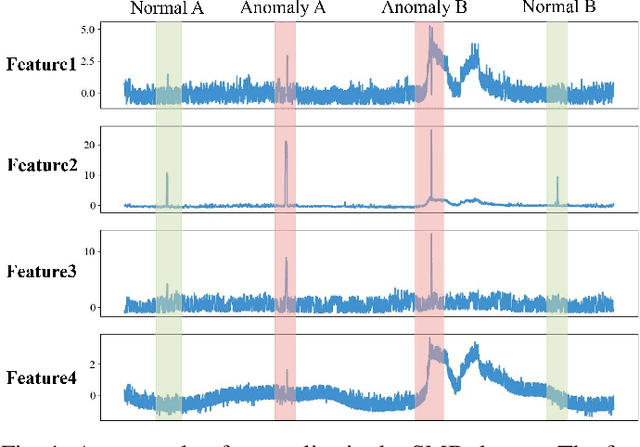
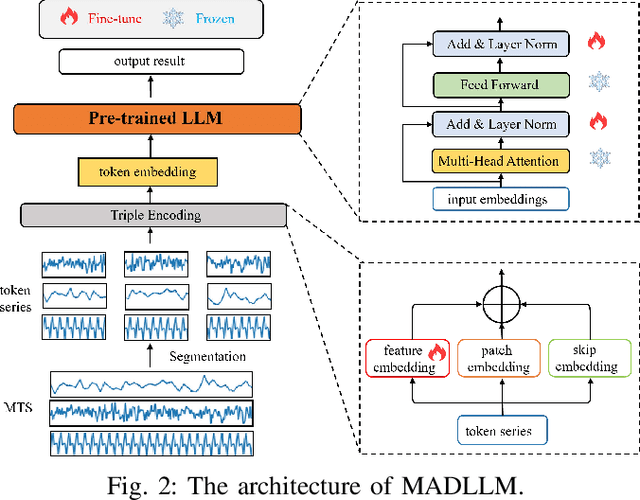
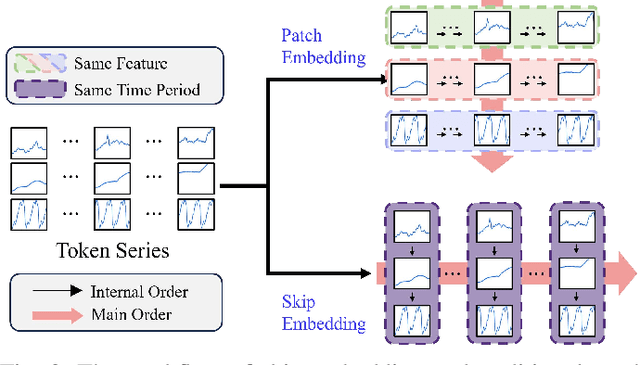

Abstract:When applying pre-trained large language models (LLMs) to address anomaly detection tasks, the multivariate time series (MTS) modality of anomaly detection does not align with the text modality of LLMs. Existing methods simply transform the MTS data into multiple univariate time series sequences, which can cause many problems. This paper introduces MADLLM, a novel multivariate anomaly detection method via pre-trained LLMs. We design a new triple encoding technique to align the MTS modality with the text modality of LLMs. Specifically, this technique integrates the traditional patch embedding method with two novel embedding approaches: Skip Embedding, which alters the order of patch processing in traditional methods to help LLMs retain knowledge of previous features, and Feature Embedding, which leverages contrastive learning to allow the model to better understand the correlations between different features. Experimental results demonstrate that our method outperforms state-of-the-art methods in various public anomaly detection datasets.
Cocktail: Chunk-Adaptive Mixed-Precision Quantization for Long-Context LLM Inference
Mar 30, 2025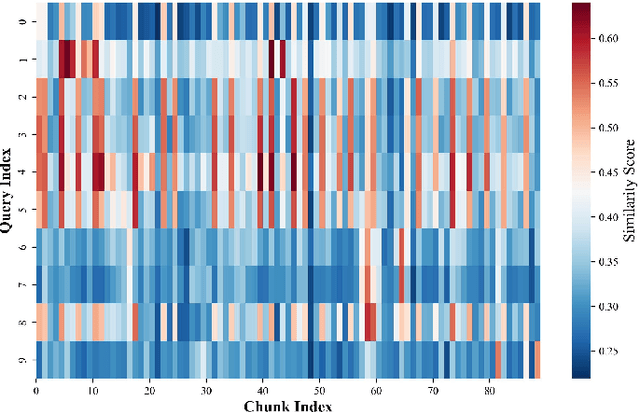
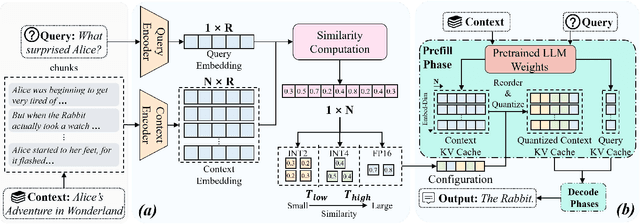
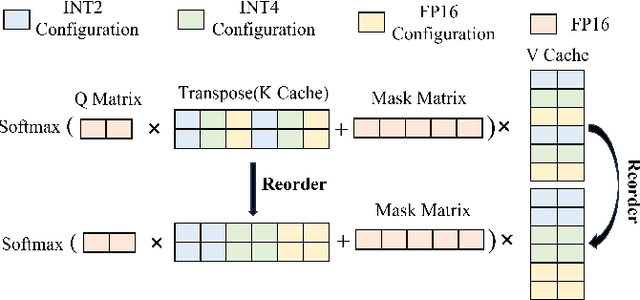
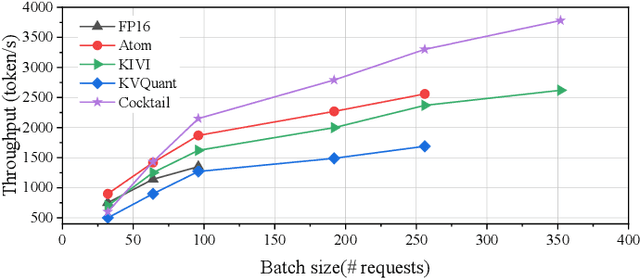
Abstract:Recently, large language models (LLMs) have been able to handle longer and longer contexts. However, a context that is too long may cause intolerant inference latency and GPU memory usage. Existing methods propose mixed-precision quantization to the key-value (KV) cache in LLMs based on token granularity, which is time-consuming in the search process and hardware inefficient during computation. This paper introduces a novel approach called Cocktail, which employs chunk-adaptive mixed-precision quantization to optimize the KV cache. Cocktail consists of two modules: chunk-level quantization search and chunk-level KV cache computation. Chunk-level quantization search determines the optimal bitwidth configuration of the KV cache chunks quickly based on the similarity scores between the corresponding context chunks and the query, maintaining the model accuracy. Furthermore, chunk-level KV cache computation reorders the KV cache chunks before quantization, avoiding the hardware inefficiency caused by mixed-precision quantization in inference computation. Extensive experiments demonstrate that Cocktail outperforms state-of-the-art KV cache quantization methods on various models and datasets.
RUNA: Object-level Out-of-Distribution Detection via Regional Uncertainty Alignment of Multimodal Representations
Mar 28, 2025Abstract:Enabling object detectors to recognize out-of-distribution (OOD) objects is vital for building reliable systems. A primary obstacle stems from the fact that models frequently do not receive supervisory signals from unfamiliar data, leading to overly confident predictions regarding OOD objects. Despite previous progress that estimates OOD uncertainty based on the detection model and in-distribution (ID) samples, we explore using pre-trained vision-language representations for object-level OOD detection. We first discuss the limitations of applying image-level CLIP-based OOD detection methods to object-level scenarios. Building upon these insights, we propose RUNA, a novel framework that leverages a dual encoder architecture to capture rich contextual information and employs a regional uncertainty alignment mechanism to distinguish ID from OOD objects effectively. We introduce a few-shot fine-tuning approach that aligns region-level semantic representations to further improve the model's capability to discriminate between similar objects. Our experiments show that RUNA substantially surpasses state-of-the-art methods in object-level OOD detection, particularly in challenging scenarios with diverse and complex object instances.
VisTa: Visual-contextual and Text-augmented Zero-shot Object-level OOD Detection
Mar 28, 2025Abstract:As object detectors are increasingly deployed as black-box cloud services or pre-trained models with restricted access to the original training data, the challenge of zero-shot object-level out-of-distribution (OOD) detection arises. This task becomes crucial in ensuring the reliability of detectors in open-world settings. While existing methods have demonstrated success in image-level OOD detection using pre-trained vision-language models like CLIP, directly applying such models to object-level OOD detection presents challenges due to the loss of contextual information and reliance on image-level alignment. To tackle these challenges, we introduce a new method that leverages visual prompts and text-augmented in-distribution (ID) space construction to adapt CLIP for zero-shot object-level OOD detection. Our method preserves critical contextual information and improves the ability to differentiate between ID and OOD objects, achieving competitive performance across different benchmarks.
Hammer: Towards Efficient Hot-Cold Data Identification via Online Learning
Nov 22, 2024Abstract:Efficient management of storage resources in big data and cloud computing environments requires accurate identification of data's "cold" and "hot" states. Traditional methods, such as rule-based algorithms and early AI techniques, often struggle with dynamic workloads, leading to low accuracy, poor adaptability, and high operational overhead. To address these issues, we propose a novel solution based on online learning strategies. Our approach dynamically adapts to changing data access patterns, achieving higher accuracy and lower operational costs. Rigorous testing with both synthetic and real-world datasets demonstrates a significant improvement, achieving a 90% accuracy rate in hot-cold classification. Additionally, the computational and storage overheads are considerably reduced.
PRENet: A Plane-Fit Redundancy Encoding Point Cloud Sequence Network for Real-Time 3D Action Recognition
May 11, 2024Abstract:Recognizing human actions from point cloud sequence has attracted tremendous attention from both academia and industry due to its wide applications. However, most previous studies on point cloud action recognition typically require complex networks to extract intra-frame spatial features and inter-frame temporal features, resulting in an excessive number of redundant computations. This leads to high latency, rendering them impractical for real-world applications. To address this problem, we propose a Plane-Fit Redundancy Encoding point cloud sequence network named PRENet. The primary concept of our approach involves the utilization of plane fitting to mitigate spatial redundancy within the sequence, concurrently encoding the temporal redundancy of the entire sequence to minimize redundant computations. Specifically, our network comprises two principal modules: a Plane-Fit Embedding module and a Spatio-Temporal Consistency Encoding module. The Plane-Fit Embedding module capitalizes on the observation that successive point cloud frames exhibit unique geometric features in physical space, allowing for the reuse of spatially encoded data for temporal stream encoding. The Spatio-Temporal Consistency Encoding module amalgamates the temporal structure of the temporally redundant part with its corresponding spatial arrangement, thereby enhancing recognition accuracy. We have done numerous experiments to verify the effectiveness of our network. The experimental results demonstrate that our method achieves almost identical recognition accuracy while being nearly four times faster than other state-of-the-art methods.
Value-Driven Mixed-Precision Quantization for Patch-Based Inference on Microcontrollers
Jan 24, 2024
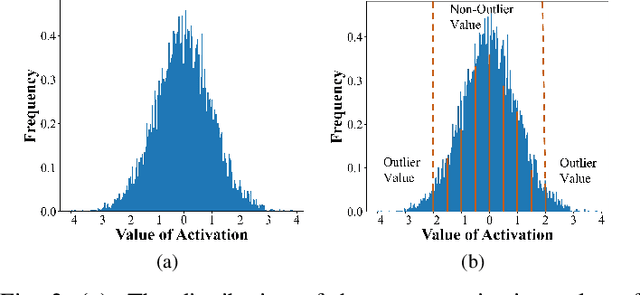
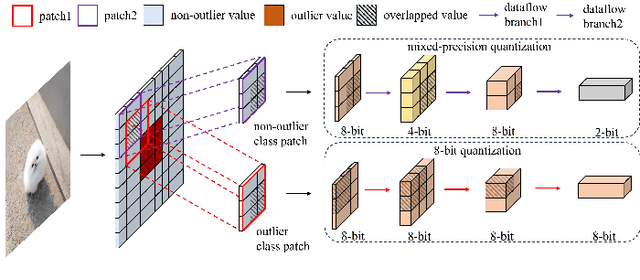
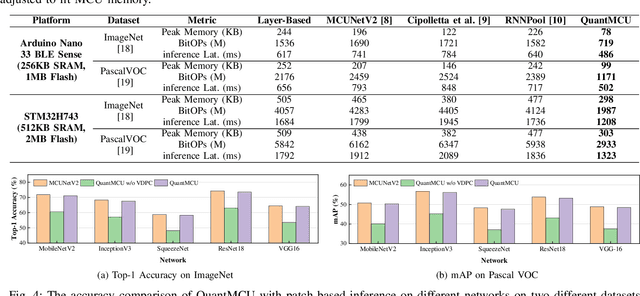
Abstract:Deploying neural networks on microcontroller units (MCUs) presents substantial challenges due to their constrained computation and memory resources. Previous researches have explored patch-based inference as a strategy to conserve memory without sacrificing model accuracy. However, this technique suffers from severe redundant computation overhead, leading to a substantial increase in execution latency. A feasible solution to address this issue is mixed-precision quantization, but it faces the challenges of accuracy degradation and a time-consuming search time. In this paper, we propose QuantMCU, a novel patch-based inference method that utilizes value-driven mixed-precision quantization to reduce redundant computation. We first utilize value-driven patch classification (VDPC) to maintain the model accuracy. VDPC classifies patches into two classes based on whether they contain outlier values. For patches containing outlier values, we apply 8-bit quantization to the feature maps on the dataflow branches that follow. In addition, for patches without outlier values, we utilize value-driven quantization search (VDQS) on the feature maps of their following dataflow branches to reduce search time. Specifically, VDQS introduces a novel quantization search metric that takes into account both computation and accuracy, and it employs entropy as an accuracy representation to avoid additional training. VDQS also adopts an iterative approach to determine the bitwidth of each feature map to further accelerate the search process. Experimental results on real-world MCU devices show that QuantMCU can reduce computation by 2.2x on average while maintaining comparable model accuracy compared to the state-of-the-art patch-based inference methods.
GAIA: Delving into Gradient-based Attribution Abnormality for Out-of-distribution Detection
Nov 16, 2023Abstract:Detecting out-of-distribution (OOD) examples is crucial to guarantee the reliability and safety of deep neural networks in real-world settings. In this paper, we offer an innovative perspective on quantifying the disparities between in-distribution (ID) and OOD data -- analyzing the uncertainty that arises when models attempt to explain their predictive decisions. This perspective is motivated by our observation that gradient-based attribution methods encounter challenges in assigning feature importance to OOD data, thereby yielding divergent explanation patterns. Consequently, we investigate how attribution gradients lead to uncertain explanation outcomes and introduce two forms of abnormalities for OOD detection: the zero-deflation abnormality and the channel-wise average abnormality. We then propose GAIA, a simple and effective approach that incorporates Gradient Abnormality Inspection and Aggregation. The effectiveness of GAIA is validated on both commonly utilized (CIFAR) and large-scale (ImageNet-1k) benchmarks. Specifically, GAIA reduces the average FPR95 by 23.10% on CIFAR10 and by 45.41% on CIFAR100 compared to advanced post-hoc methods.
EdgeMA: Model Adaptation System for Real-Time Video Analytics on Edge Devices
Aug 17, 2023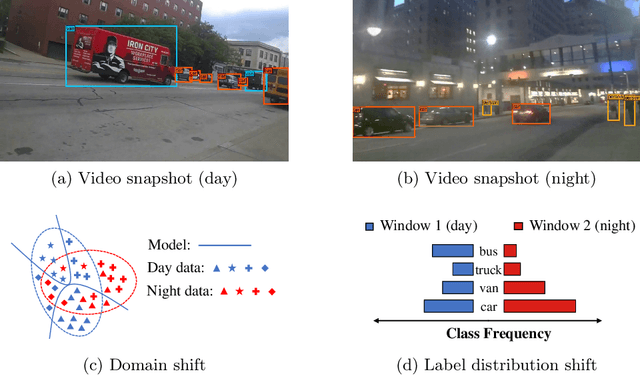
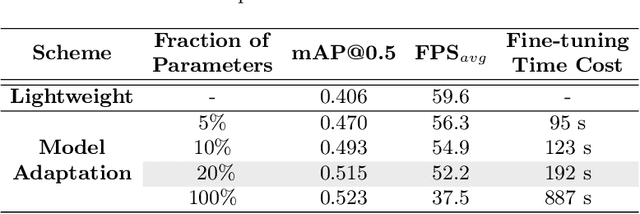
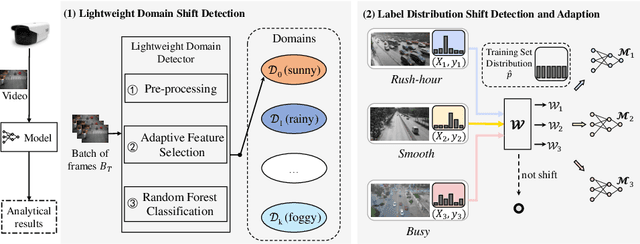

Abstract:Real-time video analytics on edge devices for changing scenes remains a difficult task. As edge devices are usually resource-constrained, edge deep neural networks (DNNs) have fewer weights and shallower architectures than general DNNs. As a result, they only perform well in limited scenarios and are sensitive to data drift. In this paper, we introduce EdgeMA, a practical and efficient video analytics system designed to adapt models to shifts in real-world video streams over time, addressing the data drift problem. EdgeMA extracts the gray level co-occurrence matrix based statistical texture feature and uses the Random Forest classifier to detect the domain shift. Moreover, we have incorporated a method of model adaptation based on importance weighting, specifically designed to update models to cope with the label distribution shift. Through rigorous evaluation of EdgeMA on a real-world dataset, our results illustrate that EdgeMA significantly improves inference accuracy.
 Add to Chrome
Add to Chrome Add to Firefox
Add to Firefox Add to Edge
Add to Edge